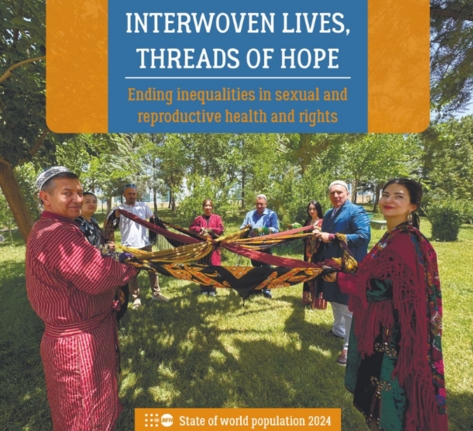The presentation of the 2024 State of World Population (SWOP) report was held in Ashgabat, timed to coincide with the annual World Population Day.
Members of the parliament, employees of the Ministry of Foreign Affairs, a number of ministries and departments, the Academy of Public Administration under the President of Turkmenistan, the Institute of State, Law and Democracy, the National Red Crescent Society, the media, as well as heads of the diplomatic missions of foreign states accredited in the country were invited to participate in the event, organized jointly by the Representative Office of the United Nations Population Fund (UNFPA) in Turkmenistan and the Government of Turkmenistan.
The flagship report titled “Interwoven Lives, Threads of Hope: Ending inequalities in sexual and reproductive health and rights”, provides an overview of the current situation in the world and the problems faced by different countries today. First of all, this concerns the empowerment of women in the field of reproductive health.
Within the framework of the event, a Memorandum of Understanding was signed between the National Red Crescent Society of Turkmenistan and the United Nations Population Fund.
As noted in the speeches, Turkmenistan’s foreign policy has predetermined the fruitful nature of country’s interaction with UN agencies, which act as long-term, strategic partners in solving topical issues of our time.
In this context, the productivity of joint work under the “UN Sustainable Development Cooperation Framework for 2021-2025” was emphasized.
Noting the successes achieved by Turkmenistan in protecting public health, ensuring gender equality and creating favorable conditions for people’s lives, empowering them, representatives of the United Nations Population Fund stressed their readiness to comprehensively increase cooperation and provide full support in the development, adoption and implementation of population policies and development strategies.
More details on the 2024 State of World Population report “Weaving a Stronger Fabric: Solutions for a More Equitable World” from UNFPA Turkmenistan
In 1994, the world united at the International Conference on Population and Development (ICPD), envisioning a future where everyone could exercise their sexual and reproductive health rights, where women and girls were empowered, and where sustainable development flourished.
Three decades later, significant progress has been made. Maternal mortality has declined, contraceptive access has expanded, and strides have been made towards gender equality. However, the 2024 State of World Population (SWOP) report, “Interwoven Lives, Threads of Hope: Ending inequalities in sexual and reproductive health and rights” reveals a stark reality: progress remains uneven, with many still facing significant challenges.
For millions, access to essential healthcare, particularly sexual and reproductive healthcare, remains limited due to factors like poverty, geographic location, and discriminatory social norms. This lack of access disproportionately affects women and girls, hindering their health, well-being, and ability to make informed choices about their lives. Despite the commitments made at the ICPD, barriers such as stigma and inadequate resources continue to delay progress towards universal access to quality care.
“One woman in four cannot make her own health-care decisions. One woman in four cannot say no to sex. And nearly 1 in 10 are unable to make their own choices about whether to use contraception. We have, for the first time, data on whether women’s bodily autonomy is strengthening over time – and in 40 percent of countries with data, it is actually diminishing,” Dr. Natalia Kanem, UNFPA Executive Director, emphasized during the launch of the State of World Population 2024.
Urgent Action for an Equitable Future: Solutions from the SWOP 2024 Report
The 2024 State of World Population report reveals stark inequalities that demand immediate action. To create a world where everyone thrives, we must dismantle the systems that perpetuate these disparities. This requires a multi-faceted approach, including:
- Transforming Systems and Structures: Collaborating with governments and community leaders to rebuild systems that ensure all 8 billion people can contribute to and benefit from a just and prosperous future.
- Eliminating Bias in Healthcare: Rooting out biases within healthcare systems to ensure equitable care for everyone, regardless of background or circumstances.
- Amplifying Vulnerable Voices: Prioritizing data collection and analysis that reflects the experiences of vulnerable groups, ensuring their needs are heard and addressed in policy and programming decisions.
- Investing in Equality: Addressing the root causes of inequality, including poverty, discrimination, and lack of access to education and healthcare.
- Combating Climate-Induced Inequality: Addressing the disproportionate impact of climate change, conflict, and demographic shifts on vulnerable populations, ensuring no one is left behind.
Dr. Natalia Kanem further stressed the need for collaborative action, stating: “Our strength, our resilience comes not from any individual strand but from the collective, interwoven whole. The way forward, how we proceed and succeed, is by working together.”
By taking these bold steps, we can weave a stronger, more resilient fabric for our global community, ensuring everyone can reach their full potential, regardless of gender, background, or circumstance. The time for action is now.
Explore the full SWOP 2024 report to delve deeper into the challenges and opportunities facing our world:
Download the English version of the report here.
Download the Russian version of the report here.
***
The State of World Population (SWOP) report is an annual publication by the United Nations Population Fund (UNFPA). First published in 1978, the report provides a comprehensive analysis of global population trends, including fertility rates, mortality rates, migration patterns, and demographic shifts. With over 40 years of data and analysis, the SWOP report serves as a critical resource for policymakers, researchers, and advocates, offering insights into the complex relationship between population dynamics and sustainable development. ///nCa, 12 July 2024
